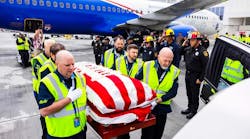The following information was released by the Aircraft Owners and Pilots Association:
By Dan Namowitz
AOPA cannot support the FAAs proposed rule to amend the regulation of Part 145 repair stations because mostly it adds up to a paperwork exercise and a burden to 5,000 aviation businesses, the association said in a regulatory filing.
AOPA offered seven recommendations to improve the proposed rule in formal comments submitted Nov.19. They included dropping a requirement to recertify existing repair stations, clarifying the rules complicated training-program requirements, and providing a cost analysis that takes into account all elements of the proposals impact on repair stations.
Certainly the FAAs resources are better spent on activities with the potential to increase safety rather than a paperwork exercise for almost 5,000 businesses, wrote Rob Hackman, AOPA vice president of regulatory affairs.
Another significant concern to general aviation owners and operators is the proposed rules potential to negatively impact repair stations ability to provide mobile maintenance, as unplanned maintenance is sometimes needed at airports with no fixed permanent repair station or other maintenance capabilities, Hackman wrote.
The FAA published its notice of the proposed rule May 21, explaining that it took the action because many portions of the existing repair station regulations do not reflect current repair station aircraft maintenance and business practices, or advances in aircraft technology.
Overreach of authority cited
However, the requirement to recertify previously certified repair entities amounts to an unreasonable overreach of authority for which the FAA provided no justification to offset burdens of time consumption and costs, Hackman wrote.
An unintended consequence of that requirement could be a decision by smaller repair businesses to allow their certification to lapse after the proposed 24-month transition periodin effect reducing the FAAs oversight of the industry.
Proposed language on direct oversight of repairs by supervisors could be taken to mean that supervisory personnel must be present for all repairs for a station, he said. The current rule, in essence, requires supervisors to oversee individuals unfamiliar with methods, equipment, or tools used in maintenance and alterations.
A clear unintended consequence of this proposed language change is a substantial increase in the cost of maintenance services in order to compensate the supervisory position, as well as a corresponding decrease in availability of maintenance services due to limited availability of supervisory personnel.
AOPA criticized the FAAs estimate of the cost of compliance as just a fraction of the true cost of this rule to repair stations, when required training, revision of manuals, and obtaining a required letter of compliance are also considered.
The FAA should include all elements of the proposal in a reevaluated cost estimate, AOPA said.
Copyright 2012 States News Service



